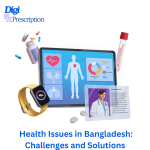
Bangladesh has made significant progress in healthcare over the past decades, but the country still faces multiple health challenges. From communicable diseases like tuberculosis and dengue to chronic conditions like diabetes and heart disease, the healthcare system is under constant pressure to address public health concerns.
Major Health Issues in Bangladesh
1. Communicable Diseases
Bangladesh continues to battle infectious diseases due to poor sanitation, overcrowding, and limited access to clean water.
Tuberculosis (TB): One of the leading infectious diseases in the country, with multidrug-resistant TB (MDR-TB) becoming a serious concern.
Dengue Fever: A seasonal epidemic that puts thousands of lives at risk every year, especially in urban areas like Dhaka.
Diarrheal Diseases: Contaminated water and poor hygiene lead to frequent outbreaks, particularly among children.
2. Non-Communicable Diseases (NCDs)
As lifestyles change, non-communicable diseases are on the rise in Bangladesh.
Heart Disease: Unhealthy diets, smoking, and sedentary lifestyles have contributed to an increase in cardiovascular diseases.
Diabetes: More than 10% of the adult population suffers from diabetes, with poor dietary habits and lack of awareness worsening the situation.
Cancer: Late diagnosis and limited access to advanced treatments make cancer one of the deadliest diseases in Bangladesh.
3. Maternal and Child Health Issues
Despite improvements in maternal healthcare, challenges remain.
High Maternal Mortality Rate: Many women in rural areas still lack access to proper prenatal care.
Child Malnutrition: Malnourishment continues to affect children under five, leading to stunted growth and developmental issues.
4. Air Pollution and Respiratory Diseases
Dhaka ranks among the most polluted cities in the world, leading to severe respiratory issues.
Asthma and COPD: Long-term exposure to air pollution increases the risk of chronic obstructive pulmonary disease (COPD).
Lung Infections: Children and elderly people are particularly vulnerable to pneumonia and bronchitis.
5. Mental Health Crisis
Mental health issues are often ignored due to stigma and lack of awareness.
Depression and Anxiety: Stress, unemployment, and economic struggles contribute to rising mental health disorders.
Limited Access to Psychiatrists: Bangladesh has a shortage of mental health professionals, making treatment difficult for many.
Challenges in the Healthcare System
Lack of Healthcare Infrastructure: Rural areas often lack well-equipped hospitals and trained doctors.
High Out-of-Pocket Costs: Many patients struggle to afford medical treatment due to high costs.
Shortage of Medical Professionals: The doctor-to-patient ratio is still low compared to global standards.
Limited Health Insurance Coverage: Bangladesh lacks a universal health insurance system, making healthcare unaffordable for many.
Solutions and Future Outlook
Expansion of Telemedicine Services: Digital healthcare solutions can help bridge the gap in rural areas.
Stronger Vaccination Programs: Immunization campaigns can prevent outbreaks of infectious diseases.
Public Health Awareness Campaigns: Educating people on hygiene, nutrition, and lifestyle diseases can reduce health risks.
Government Investment in Healthcare: More funding is needed to improve hospital infrastructure and train medical professionals.
Conclusion
Bangladesh faces multiple health challenges, but with strategic improvements in healthcare infrastructure, awareness programs, and digital health services, the situation can improve. The focus should be on prevention, early diagnosis, and affordable treatment to ensure a healthier population.
References:
World Health Organization (WHO) – Bangladesh Health Profile
Bangladesh Health Watch Report – Healthcare Challenges
UNICEF Bangladesh – Maternal and Child Health
International Centre for Diarrhoeal Disease Research, Bangladesh (icddr,b) – Infectious Disease Control
